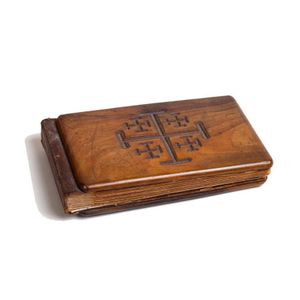Victorian Inlaid Rosewood Glove Box
You must be a subscriber, and be logged in to view price and dealer details.
Subscribe Now to view actual auction price for this item
When you subscribe, you have the option of setting the currency in which to display prices to $Au, $US, $NZ or Stg.
- Ebony - Ebony is a close grained timber, black in colour. It has a fine texture which can be polished to a high gloss, making it suitable for venereering, inlay and stringing and its use as solid timber is resticted to small decorative items and ornamental decoration, such as chess pieces and musical instrument parts. The term "ebonised" means "faux ebony", timber that has been darkened during the polishing process to resemble ebony.
- Rosewood - A dense timber that varies in shade to very light brown to almost black. When rosewood is cut and sanded the colour of the timber will turn black, and after polishing and exposure to daylight, the surface will gradually lighten over time to light brown with black streaks.
The name comes from the odour emanating from the timber when it is planed, sanded or cut.
Rosewood was very popular for use in Victorian furniture in the second half of the 19th century, and at that time most of the rosewood was imported from Brazil. However it also grows in India and Indonesia.
It is used in the sold for chairs and table legs, but for carcase furniture such as side cabinets and bookcases, and for table tops it is always used as a veneer. - Victorian Period - The Victorian period of furniture and decorative arts design covers the reign of Queen Victoria from 1837 to 1901. There was not one dominant style of furniture in the Victorian period. Designers used and modified many historical styles such as Gothic, Tudor, Elizabethan, English Rococo, Neoclassical and others, although use of some styles, such as English Rococo and Gothic tended to dominate the furniture manufacture of the period.
The Victorian period was preceded by the Regency and William IV periods, and followed by the Edwardian period, named for Edward VII (1841 ? 1910) who was King of the United Kingdom and the British Dominions and Emperor of India for the brief period from 1901 until his death in 1910. - Bird's Eye Maple - Bird's eye maple is a type of wood that is characterized by its unique, small, round eyes or spots that are scattered throughout the wood. These spots are caused by a genetic defect in the tree, and they give the wood a distinctive, swirling pattern that is highly sought after by woodworkers and furniture makers.
Bird's eye maple is harvested from the hard maple tree, which is native to Northern Europe and North America. The wood is generally pale in colour, with shades of cream, white, or light brown. The bird's eye figure is most seen in hard maple, but it can also be found in other species of maple such as the big leaf maple and silver maple, but hard maple is the most common.
It became fashionable in furniture manufacturing for use as a decorative veneer from the late 18th century to the late 19th century.
As well as furniture making, it is also used in musical instruments such as guitar, drums, and pianos and smaller decorative items such as various type of boxes such as tea caddies and in picture frames. - Maple - Maple, native to North America, is a dense heavy timber from light to yellow-brown in colour. It has very little distincive graining unless it is one of the variants such as birds-eye maple or burr maple, so was not used extensively for furniture in 18th and 19th century, where cabinetmakers and designers preferred timbers with more distinctive features such as mahogany, walnut, rosewood and oak.
Birds-eye maple has a seres of small spots linked by undulating lines in the grain, is highly sough and is used as a decorative veneer. Burr maple has larger and irregular grain swirls than birds-eye maple.
This item has been included into following indexes:
Visually similar items

A Victorian olive wood cased notebook with Hebrew inscriptions to back containing pressed flowers, circa 1880, 10 x 4 cm

Indian red lacquer lidded box, with festive elephant decoration, 39.5 x 25 cm, 15.5 cm high

Antique cut steel & inlay timber stationary box 16 cm wide approx.

A Faberge cigarette case in Karelian birch mounted in silver-gilt with a cabochon ruby Thumbpiece, Workmaster Victor Aarne (1863-1934), St Petersburg hallmark for 1899-1908, Faberge cigarette cases are among the most attractive of the objects produced by t
